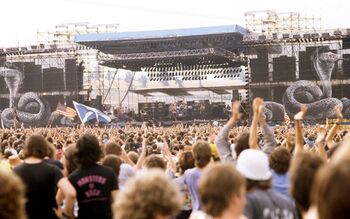Entertainment rigging is used to create temporary stages, indoors and out. Truss systems and chain hoists support lighting and sound equipment for a wide variety of events, and even becoming part of the scenography itself.
The development of truss (Q3773) as we know it today began towards the end of the 1970s when the entertainment industry was searching for a simple and efficient mean of manufacturing light but also safe supporting structures. The huge growth in demand for popular music during the 1960s had propelled a move from indoor venues with their own permanent sound and lighting installations to arenas, college campuses, gymnasiums, city squares and – above all – rural fields. The pioneering large-scale, outdoor festivals such as Jazz Bilzen (from 1965), the Isle of Wight Festival (1968), and Woodstock (1969, Q74) started to create the stage, and the required supports for lighting and sound equipment, by using lightweight wooden structures and standard steel scaffolding from building sites. Festivals and concerts rapidly became a new industry, fueled by the growth of record sales. Bands and their promotors wanted to put on bigger and better shows to draw an audience and build a following for the band’s music; lighting needed to be more spectacular, and sound needed to reach much larger audiences. Early rock concerts used only the ‘backline’ speakers on stage, and a couple of speakers for vocals, but to reach a big crowd, the speakers needed to be raised up. All this required lighting and sound equipment to be suspended above and to the sides of the stage, and scaffolding structures were no longer sufficient.
Manufacturers started to develop truss systems specifically for stage use: structures able to take substantial loads and span the width of large stages. Aluminium quickly became the preferred material, as it is not only durable but also lightweight, making rigging easier and reducing transport costs. Connection systems were developed to make assembly and disassembly as quick as possible – especially important for shows that toured, as many bands did.
Aluminium is difficult to weld, requiring specialist equipment and skilled welders. This created an opportunity for new manufacturers, who brought the needed know-how from other industries – for example, James Thomas Engineering, which started in a small garage in Bishampton, England in 1977, making truss systems and related staging equipment, mainly for the live music industry. The company grew rapidly, moving into a converted office unit, then to a much larger 464.5 m² space in 1980. Innovation was rapid at that time, as manufacturers tried to satisfy the needs of concert touring. In 1983, James Thomas developed a pre-rigged truss design, so that the lights could stay rigged to the truss for transport; sections of truss with the lights still attached could be rolled directly onto a truck, then rolled straight onto stage and assembled at the next venue.
As the scale and creative ambitions of the shows developed, truss became not just a place to hang lights, speakers and other technical equipment, it became integral to the design of the show itself. Lighting designers recognised that, as well as creating architectures of light beams in the air, they could use the shape made by the truss structure as part of the aesthetics; trusses were built in the form of triangles, fans, stars. Later, these shapes were made mobile, changing during the show into different configurations.
Truss systems are just one part of entertainment rigging. A truss structure is either ground-supported, with vertical legs of truss holding up the part over the stage, or flown, suspended from the roof of the venue. Either way, the truss needs to be raised into position. The electric chain hoist (Q30610) first appeared in the 1930s, as a development of earlier manual hoists, which were themselves based on ‘block and tackle’ systems from Antiquity. Chain hoists became the standard way of lifting truss structures and other loads. On larger or more complex installations, control systems were developed to operate multiple hoists together, ensuring they worked in synchrony.
During the 1980s, the corporate event industry took off, producing large scale productions such as product launches and trade shows. Drawing on the skills and understanding of how to make thrilling experiences for an audience found in theatre and the live music industry, rigging became a central part of the expanded field of the entertainment industry. Whenever a temporary stage is required – indoors or out, for theatre, music, festival, corporate events, sports and other ceremonies – entertainment rigging, born on the rock concert stages of the 1960s, will be present.

